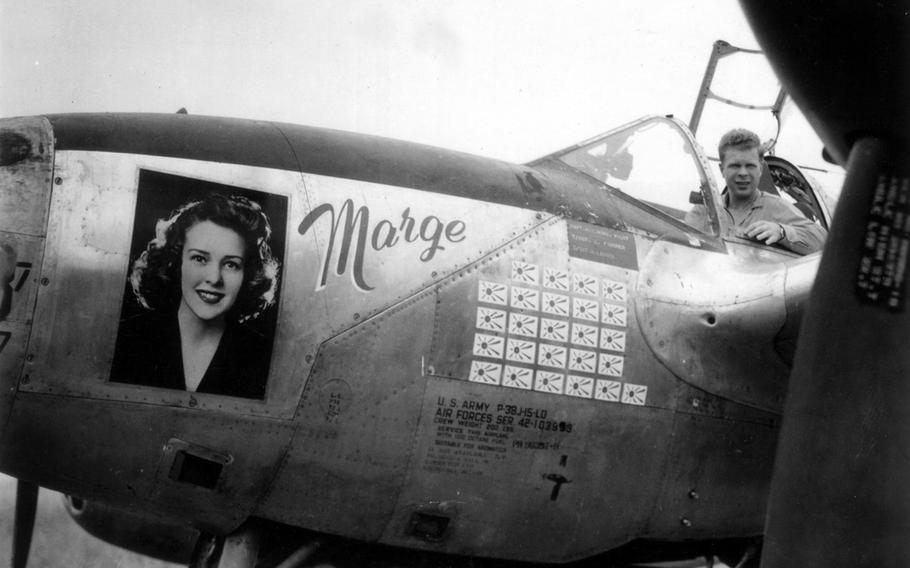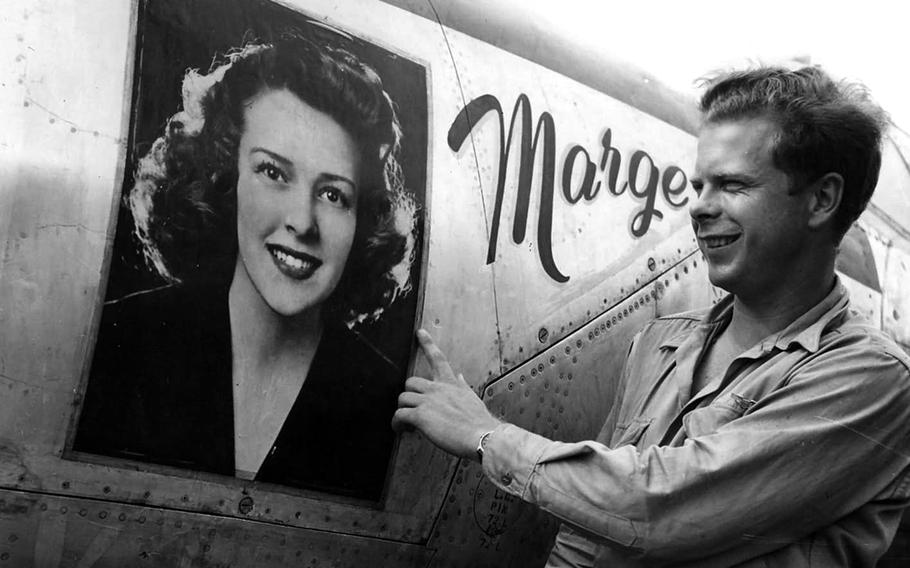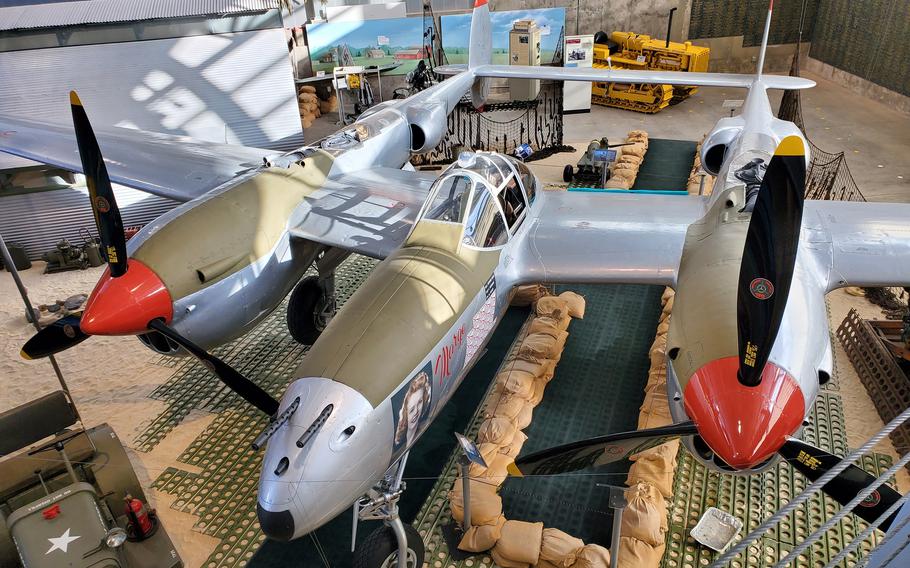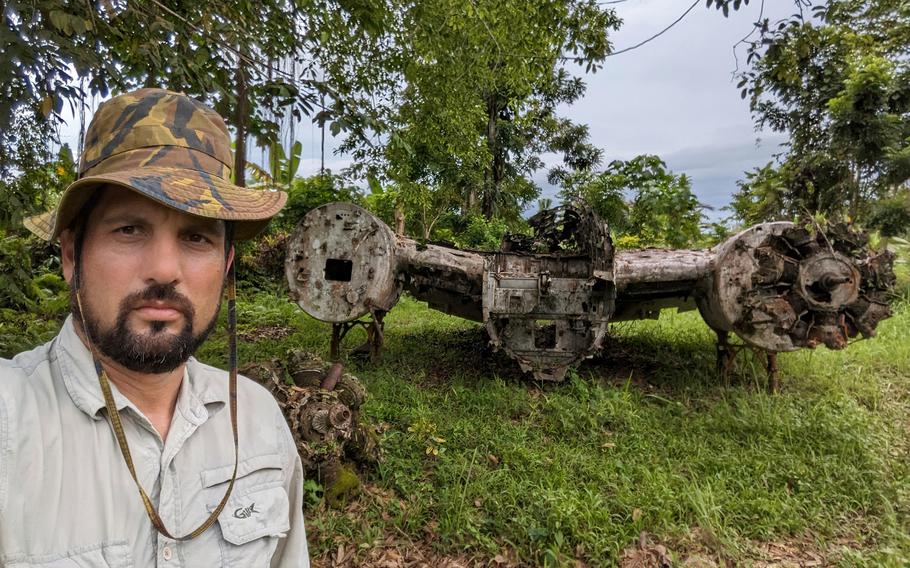
In this photo taken in March 1944 in the Pacific, Richard Bong, then a captain in the U.S. Army Air Force, sits in the cockpit of his P-38 fighter plane adorned with an image of his girlfriend, Marge, and a scoreboard tallying his 25 aerial victories over Japanese aircraft. (U.S. Army Air Force)
Last September, Justin Taylan received an email from a museum curator asking whether one of the most famous aircraft from World War II remained in Papua New Guinea where it crashed in 1944.
As director of the nonprofit search-and-recovery organization Pacific Wrecks, Taylan had been fielding queries about WWII aircraft crash sites for almost 30 years. But the question about this P-38 — nicknamed Marge by Capt. Richard Bong, America’s top flying ace — stumped him.
“I replied to the email truthfully, saying, ‘I don’t know. But let’s find out,’ ” Taylan said by phone March 28.
Months later, Taylan is preparing to lead a team to Papua New Guinea to locate and document the famous wreck in a joint project with the Richard I. Bong Veterans Historical Center in Superior, Wis.
If the wreckage still exists, it will be in a very remote area in this mountainous nation in Oceania, Taylan said.
“I can’t promise anything to anyone,” he said. “It’s possible that local people have removed the wreckage for scrap metal, or an earthquake or tornado has covered it under tons of earth that can’t be moved reasonably. But there’s no way to know for sure until we get there.”
An aerial record still standing
Bong, a Wisconsin native, enlisted in the U.S. Army Air Corps in May 1941 as an aviation cadet and was commissioned a second lieutenant in the Army Air Force a year later.
He was soon flying a P-38 Lightning, an astounding double-engine flying machine powerful enough to climb 3,300 feet in one minute and achieve a top speed of 400 mph, about 100 mph faster than any other fighter existing at the outbreak of WWII.
P-38s carried four 50-caliber machine guns and a 20 mm cannon.
Bong was a deft pilot who seized the P-38’s monster weaponry to claim his first two aerial kills in December 1942 over Buna, New Guinea.
At five aerial victories a month later, he earned the title “ace.”
In April 1944, he exceeded the 26 aerial kills claimed by America’s top World War I ace, Edward Rickenbacker, making Bong the highest scoring ace in U.S. history, a title still standing.
Along the way he was awarded the Silver Star, Distinguished Service Cross and Medal of Honor.
Bong flew a series of P-38s during the war, but one was highly celebrated.
In February 1944, Bong was assigned a new P-38 that he personalized as his own. He christened the plane Marge after his girlfriend, Marjorie Vattendahl, and placed a large portrait of her on the aircraft’s nose. Near her image was a scoreboard tallying his aerial kills.

Richard Bong shows off the portrait of his girlfriend on the nose of his P-38 fighter in this photo taken in March 1944 in the Pacific. (Richard I. Bong Veterans Historical Center)
The public gobbled up the newspaper accounts of Bong’s flying prowess and his devotion to his girl back home.
Bong was credited with three aerial victories while piloting his homage to Marge.
On March 24, 1944, another pilot, 2nd Lt. Tom Malone, was flying Bong’s plane on a weather reconnaissance mission over New Guinea when electrical malfunctions forced him to bail out at about 11,000 feet.
Bong, who was promoted to major, went on to fly more missions in other planes, racking up 40 aerial victories before he was brought back to the U.S. mainland in early 1945. There, he married Vattendahl, hawked war bonds and became a test pilot for the first jet fighters.
Bong’s untimely death later that year should have been major news, but it was eclipsed by a cataclysmic event.
He crashed while flying a P-80 Shooting Star jet fighter shortly after taking off in Southern California on Aug. 6, 1945, the same day America dropped the atomic bomb on Hiroshima.

A P-38 Lightning fighter, with markings replicating the original Marge aircraft, sits on display at the Richard Bong WWII Heritage Center in Superior, Wis. (Richard I. Bong WWII Heritage Center)
Down a rabbit hole
Early in 2023, Briana Fiandt, curator at the Bong historical center, met several individuals who had ties to Papua New Guinea, and the subject of Bong’s P-38 came up.
Curiosity about what might have become of the famous Marge “sent me down this rabbit hole of research,” Fiandt said by phone April 3.
“I guess I just couldn’t believe it, as I was doing my research, that nobody had ever [searched for] it before,” she said. “I assumed I was going to go do my research and then find out, yep, somebody in the ‘90s went out there and documented it or found that it wasn’t out there.
“Nobody from our organization had ever thought to go look for it before.”
That led her to Taylan, who estimates he has visited the sites of more than a thousand aircraft wrecks in the Indo-Pacific since traveling at age 16 with his grandfather in the 1990s to Papua New Guinea to visit former battlefields.

Justin Taylan, founder and director of Pacific Wrecks, stands beside World War II aircraft wreckage in Papua New Guinea in May 2023. (Pacific Wrecks)
Taylan has primarily hunted for aircraft associated with missing-in-action service members, with the goal of finding their remains so that an official accounting of MIAs could be made by the U.S. government.
No MIAs are associated with Marge, and, technically, the plane is not even “lost,” Taylan said.
“Several days after the crash, the crash site was discovered by a U.S. Army patrol,” he said.
But they paid it little mind, as pilot Malone had bailed and made it back to safety, and the New Guinea landscape was littered with crashed Allied and Japanese aircraft, he said.
Malone died in 2005, but Taylan said he has reviewed letters he wrote about the day of the crash.
Taylan’s search team, which will include documentarians, archeologists and locals familiar with the countryside, will perform a survey of the site if it is found. No artifacts will be removed, he said.
Portions of the excursion, which will likely begin later this month, will be livestreamed at p38marge.org, depending upon internet access, he said.
Taylan is optimistic the site will be found.
“I never go into any investigation half-cocked, I guess you could say in military terms,” he said jokingly.
“I’m confident that there will be something to find there, but it’s not going to be an intact airplane,” he said. “It’s going to be a crash site. It’s going to look like perhaps a pile of junk. But this will be the most historically important pile of junk in the Asia-Pacific region.”